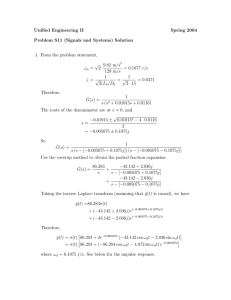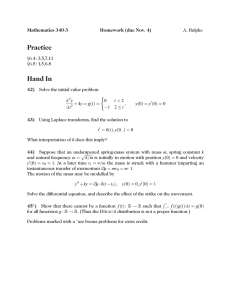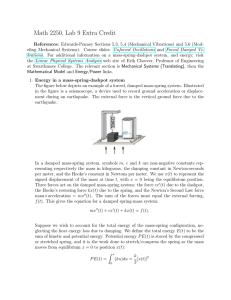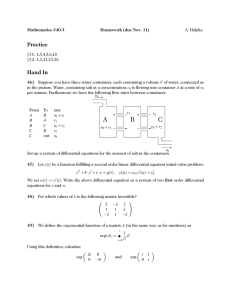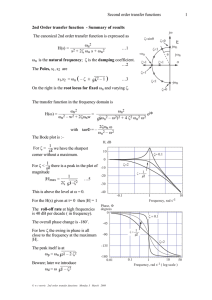EG1110 SIGNALS AND SYSTEMS Second order systems Overview
advertisement
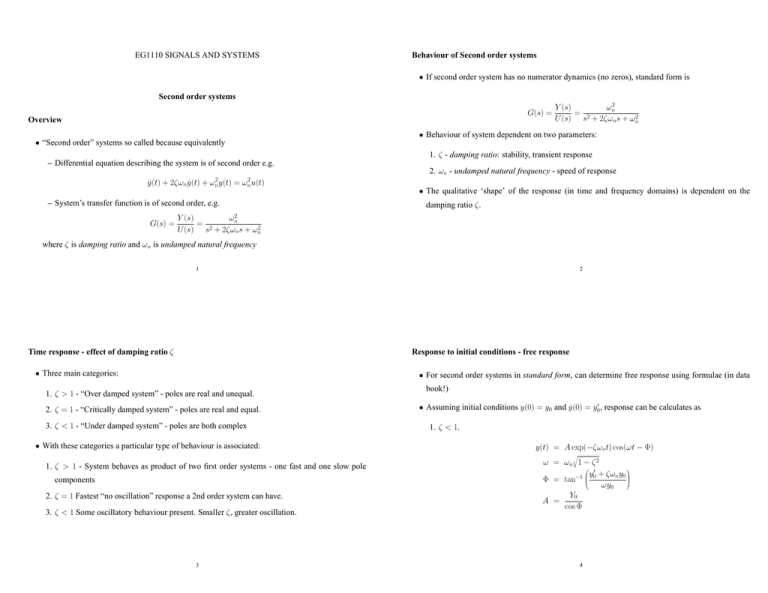
EG1110 SIGNALS AND SYSTEMS Behaviour of Second order systems • If second order system has no numerator dynamics (no zeros), standard form is Second order systems G(s) = Overview • “Second order” systems so called because equivalently Y (s) ωn2 = 2 U (s) s + 2ζωns + ωn2 • Behaviour of system dependent on two parameters: 1. ζ - damping ratio: stability, transient response – Differential equation describing the system is of second order e.g. 2. ωn - undamped natural frequency - speed of response ÿ(t) + 2ζωnẏ(t) + ωn2 y(t) = ωn2 u(t) – System’s transfer function is of second order, e.g. • The qualitative ‘shape’ of the response (in time and frequency domains) is dependent on the damping ratio ζ. Y (s) ωn2 G(s) = = U (s) s2 + 2ζωns + ωn2 where ζ is damping ratio and ωn is undamped natural frequency 1 Time response - effect of damping ratio ζ 2 Response to initial conditions - free response • Three main categories: • For second order systems in standard form, can determine free response using formulae (in data 1. ζ > 1 - “Over damped system” - poles are real and unequal. 2. ζ = 1 - “Critically damped system” - poles are real and equal. 3. ζ < 1 - “Under damped system” - poles are both complex • With these categories a particular type of behaviour is associated: 1. ζ > 1 - System behaves as product of two first order systems - one fast and one slow pole components 2. ζ = 1 Fastest “no oscillation” response a 2nd order system can have. 3. ζ < 1 Some oscillatory behaviour present. Smaller ζ, greater oscillation. 3 book!) • Assuming initial conditions y(0) = y0 and ẏ(0) = y00 , response can be calculates as 1. ζ < 1. y(t) = A exp(−ζωnt) cos(ωt − Φ) r ω = ωn 1 − ζ 2 y00 + ζωny0 Φ = tan−1 ωy0 Y0 A = cos Φ 4 2. ζ = 1 Qualitative behaviour - time domain y(t) = (y0 + Bt) exp(−ωnt) • Effect of damping ratio demonstrated by observing response of second order system to unit step B = ωny0 + y00 (1) input: 1.6 3. ζ > 1 1.4 s2 = −ωn[ζ + ζ 2 − 1] s2y0 − y00 A1 = s2 − s1 s1y0 − y00 A2 = s1 − s2 • Note that in all cases the initial conditions (y0, y00 ), 0.8 0.8 0.7 1 0.7 0.8 0.6 Response − normalised units − 1] r Response − normalised units Response − normalised units s1 = −ωn[ζ − ζ2 1 0.9 1.2 y(t) = A1 exp(s1t) + A2 exp(s2 t) r 1 0.9 0.6 0.5 0.4 0.3 0.2 0 • Bode plots of second order system are similar except for the decades above and below the undamped natural frequency. Bode Diagram −20 0 −20 −20 −40 −40 −60 −40 0 −80 0 −80 0 −45 −45 −45 Phase (deg) −90 −135 −180 −1 10 Phase (deg) −60 −30 Phase (deg) Bode Diagram 0 Magnitude (dB) Magnitude (dB) Magnitude (dB) 0 −90 −135 0 10 Frequency (rad/sec) 1 10 −180 −2 10 −90 −135 0 10 Frequency (rad/sec) 7 2 10 0.3 0 5 10 15 Time − seconds (underdamped) 20 0.2 0.1 0.1 0 0 5 10 15 Time − seconds (critically damped) 6 Qualitative behaviour - frequency domain −10 0.4 0.2 the damping ratio (ζ) and undamped natural 5 Bode Diagram 0.5 0.4 frequency (ωn) completely determine the free response of the system. 10 0.6 −180 −2 10 0 10 Frequency (rad/sec) 2 10 20 0 0 5 10 15 Time − seconds (over damped) 20


